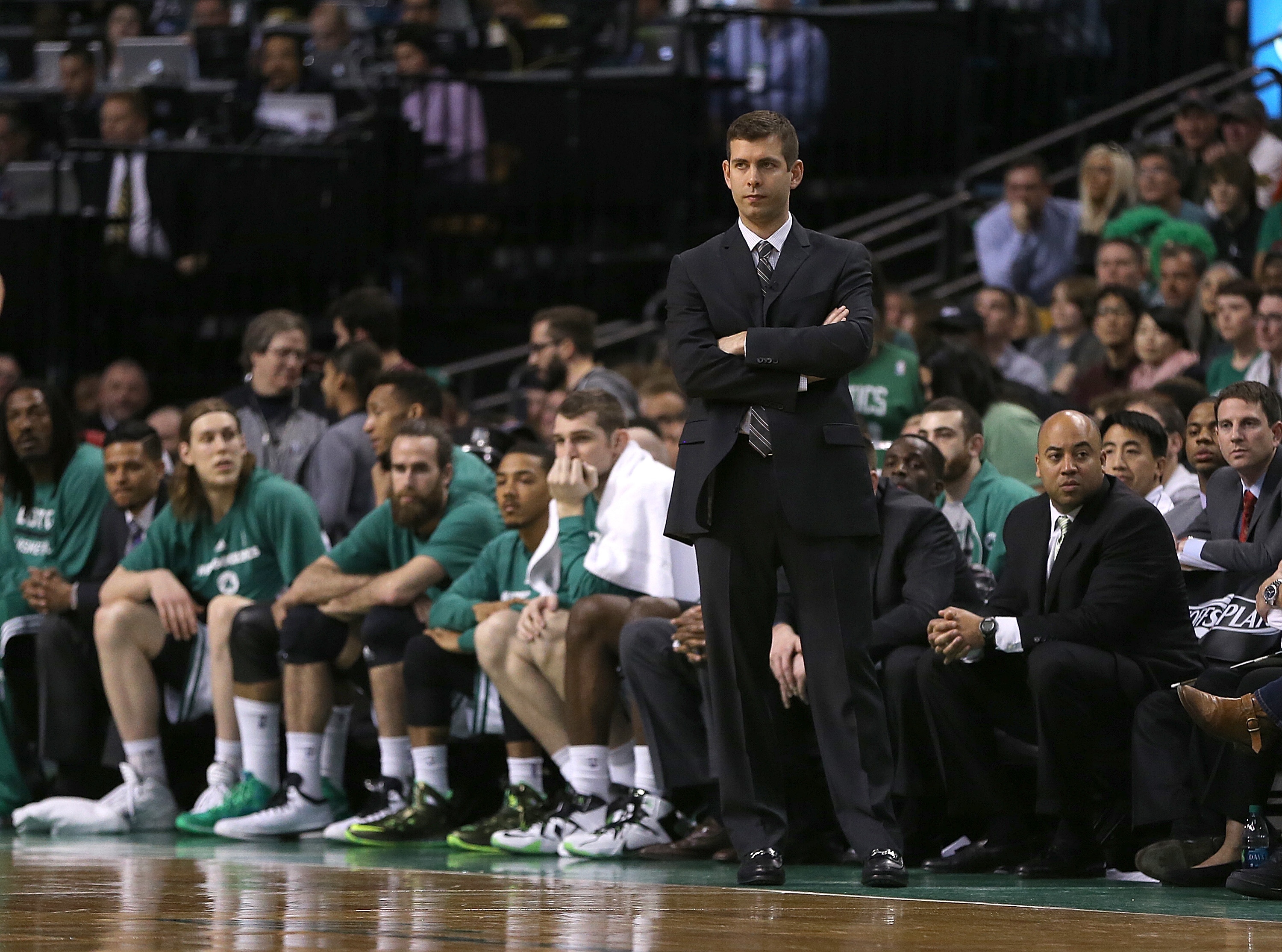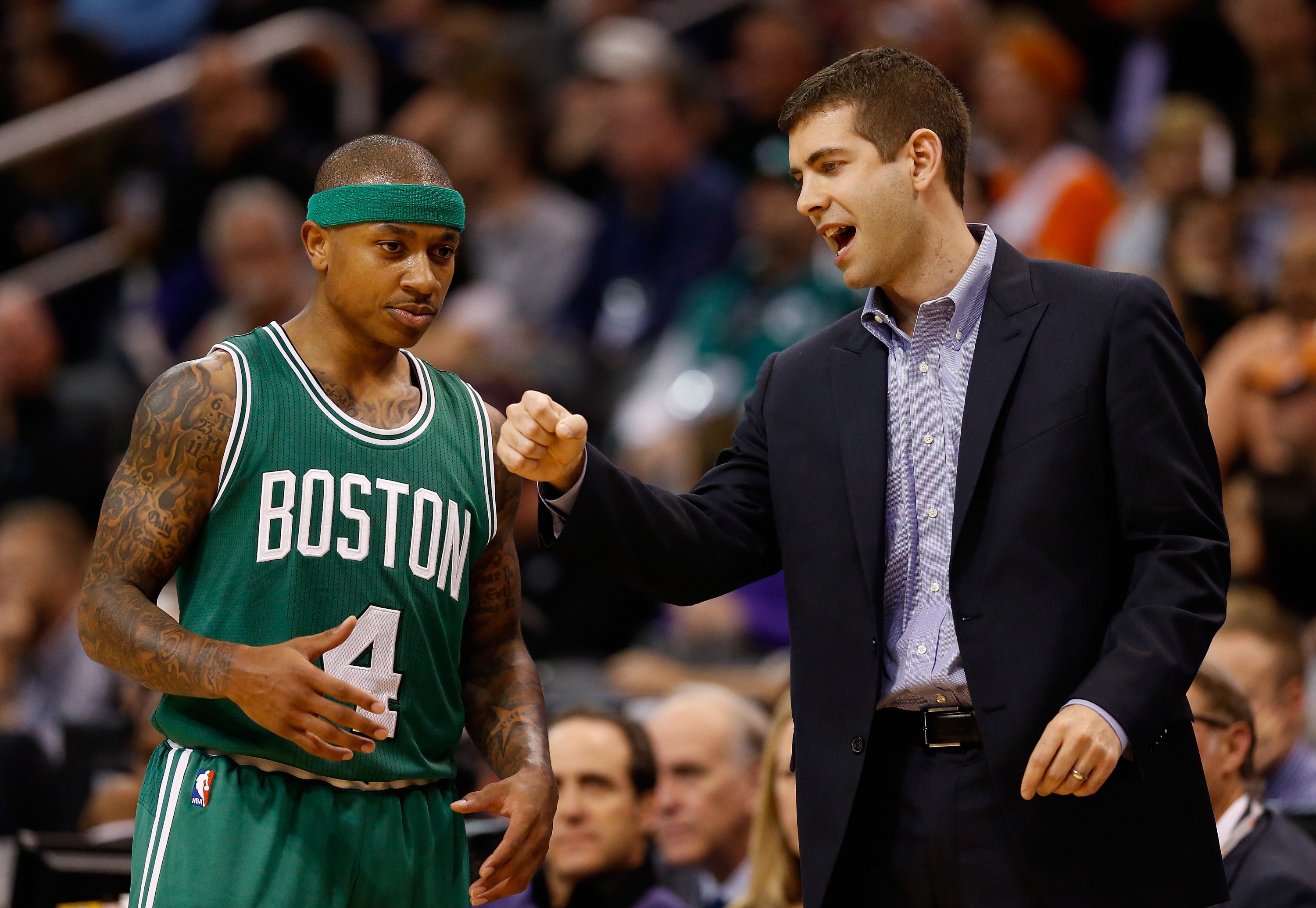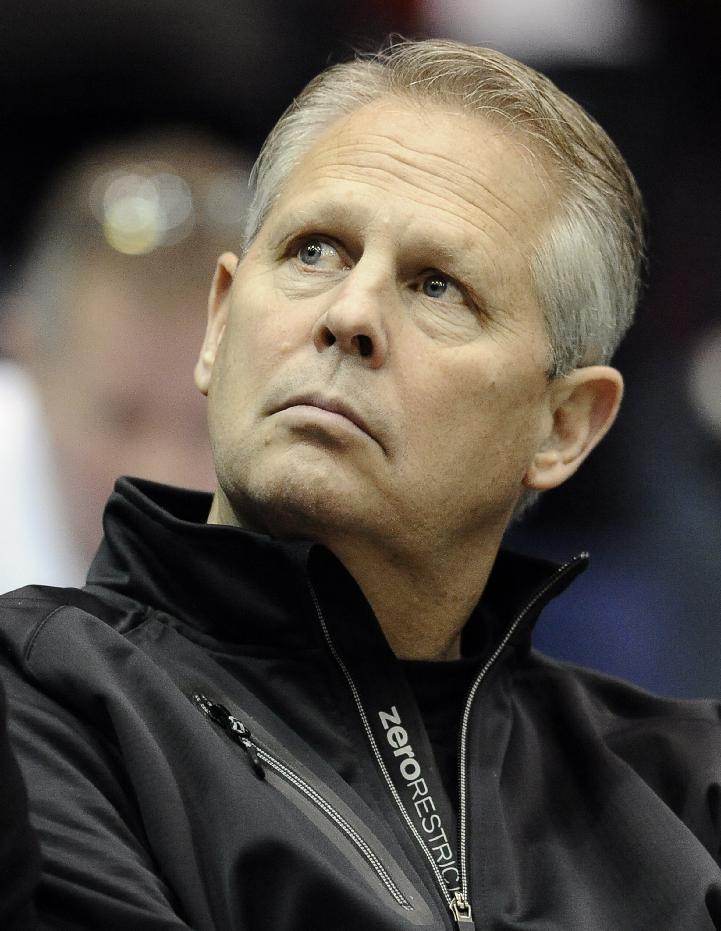BDL 25: The rise of Brad Stevens and his starless Celtics
The NBA offseason has brought many changes to rosters, coaching staffs, and the list of championship contenders. As we draw closer to opening night, it’s time to move our focus from the potential impact of each offseason event and onto the broader issues that figure to define this season. The BDL 25 takes stock of, uh, 25 key storylines to get you up to speed on where the most fascinating teams, players, and people stand on the brink of 2015-16.
WALTHAM, Mass. — Brad Stevens appears older, the way you can just tell a high school junior from a sophomore. It’s hard to pinpoint. Could just be the confidence.
That isn’t to say the Celtics coach is old, by any stretch of the imagination. He’s younger than three active NBA players (Kevin Garnett, Tim Duncan, Andre Miller). He still looks like a fresh-faced hire at a pharmaceutical company, which is what he was before getting into the coaching racket, and there isn’t a gray hair on his head.
Entering his third season in Boston, Stevens is quite comfortable in his seat on the bench of the league’s most decorated franchise. On the cusp of his 39th birthday, he’s already one of the NBA’s brightest basketball minds. For those who disagree, consider his fourth-place finish in the 2014-15 Coach of the Year race as validation.
“Coach’s knowledge of the game is unbelievable,” says David Lee, the former All-Star who the Celtics acquired from Golden State for Gerald Wallace’s expiring contract, “and I think the biggest compliment I can give him — and it’s the same compliment I gave Steve Kerr last year — is that his personality fits the team’s personality well.”
[Follow Dunks Don’t Lie on Tumblr: The best slams from all of basketball]
The starless C’s made a stunning run to the playoffs after losing their top scorer (Jeff Green), playmaker (Rajon Rondo) and rebounder (Jared Sullinger) to trades and injury. History suggests it’s impossible to be a contender without superstar talent, a narrative reinforced by the Cleveland Cavaliers’ first-round sweep of those same Celtics. Even team president Danny Ainge concedes, “Transcendent players are what everybody would like to have in the NBA. You don’t always get what you want.”
The Celtics cycled through 33 players during Stevens’ first two seasons, 22 of whom appeared in uniform during the 2014-15 campaign. Remarkably, there are only two players remaining from the Paul Pierce and Kevin Garnett era — Sullinger and Avery Bradley — and only Bradley played more games for Doc Rivers than Stevens.
“A system is continually changing, depending on your personnel,” says Ainge, who signed Stevens to a six-year deal in 2013. “Brad’s a really smart coach. He spends a lot of time preparing. His system will be determined by the personnel he has. He doesn’t have a system. He’s a basketball coach, and he coaches the players that he has. He’s done a great job of that, and I think he’ll continue to do a great job of that.”
Between December 2014 and February 2015, Ainge completed seven trades involving 10 teams and 17 players, ultimately swapping Rondo, Green, Marcus Thornton and Dwight Powell for Isaiah Thomas, Jae Crowder, Jonas Jerebko and Gigi Datome. Yet, after Feb. 3, only the five title favorites — the star-studded Warriors, Spurs, Cavaliers, Clippers and Rockets — owned a higher winning percentage.
“We played the Celtics twice, and they had us beat twice. And I thought we were a pretty good team last year in Golden State,” adds Lee, whose Warriors won both meetings by single digits. “I noticed the depth and how hard they played, and those are things that translate no matter what conference you’re in. They also seemed like they were very well coached, and that seems to be the case since I’ve been here.”
Ainge has built a roster in the mold of his coach — high motor, high IQ and high character. In addition to trading for Lee, the Celtics signed universally respected veteran Amir Johnson, their biggest free-agent addition in years, and then re-upped both Crowder and Jerebko, a pair of players whose versatility fit Stevens’ philosophy (the more you can do, the better) and whose energy helped spark the stretch run.
“Being comfortable played a big role in my decision,” says Crowder. “I didn’t want to go anywhere where I felt like I didn’t know what to expect. I knew exactly what I was going to get from Brad. I knew exactly what he wanted from me as a player, and was comfortable playing under him, so it played a big role in my decision, for sure.”
“Definitely,” adds Jerebko, whose production also increased after coming to Boston. “Being in an organization that changed coaches every year I was there and learning a new system is hard. So, coming back to this, knowing what I’m coming back to — and I know I’m coming back to a great coach and a great coaching staff that is going to put us in the best position to win — obviously was a big, big part of my decision.”
None of these names will wow anybody. Lee was last an All-Star in 2012-13 before losing his starting job to Draymond Green last season, and Thomas wants to be one this year. They maybe have a pair of All-Defensive talents in Bradley and Marcus Smart. Other than that, the Celtics have 15 roster spots for 16 players, and there is serious debate about who will be the odd man out come the end of training camp.
Stevens’ second unit (rookie Terry Rozier, Thomas, Evan Turner, Sullinger and Tyler Zeller?) might be as talented as his starters (Smart, Bradley, Crowder, Lee and Johnson?), and that 10-man rotation leaves out guys like Jerebko and Kelly Olynyk.
“Every good team you’re going to have discussions like that,” says Stevens. “Every good team that’s challenging to be better is going to have depth. We’re going to have good players on our team who aren’t going to play. That’s the reality of it. That’s the hard part of the job in some ways, but I think you just try to be really frank and talk about it. I’m not here to predetermine anything. That’s why I think we should probably have media day two weeks in, because I don’t know yet. We’ll find out.”
Are the Celtics actually any good, though? They finished 40-42 in the East and failed to win a playoff game, even if they played the Cavs tough in all four of them. While they submitted a top-10 defense during their 24-12 finish to the regular season, Boston featured a middling offense during that same stretch, particularly when Thomas was off the floor, and mostly because they were one of the league’s worst 3-point shooting teams despite attempting more 3’s than all but six squads. It’s one thing to position players for shots; it’s another to get the ball through the hoop.
“Brad talks a lot about playing with pace and space,” says Ainge, “and I think we do have better shooting. Although, we need our guys who aren’t shooting as well to be better, but I think we’re going to be an improved shooting team this year.”
Stevens literally boils the game down to each possession, because it levels the playing field. If you can win one possession against a LeBron James-led team, you can win the next. Win more than the other guy over the course of a game, and you’ve done your job. Do it for a full season, and you’re golden. Then do it again in the playoffs. It’s a philosophy that served him well at Butler, where his mid-major Bulldogs challenged NCAA Goliaths Duke and UConn in consecutive title games.
“We learned as a team that the margin of error is very small,” says Smart, a Second Team All-Rookie selection. “It just takes one mistake that can cost you the rest of your season and the playoffs. That one turnover, that one missed block-out can cost you that game, and in the playoffs every game counts and every possession matters.”
So much so that there was a concern inside the organization that Stevens was trying to do too much, designing defenses specifically tailored to each team rather than tweaking a scheme like the one Tom Thibodeau made so successful in Boston. While Stevens’ approach seems sound in theory, it’s nearly impossible to adjust on the fly when your team is playing on back-to-back nights and four games in five days. Last year’s ever-changing roster eventually forced him into finding a delicate balance.
[Yahoo Daily Fantasy Football: Enter our $1 Million Week 4 contest]
“Personally, it’s going to help me a lot to get more familiar with Brad’s system,” said Thomas. “Last year, even throughout the playoffs, when I got in the game, it was kind of like, ‘Just space the floor and pick and roll,’ because I didn’t really get any practices in, especially when I got hurt. We didn’t have time for practice. Having a full training camp and getting familiar with my teammates is only going to help us.”
Stevens admits he’s less analytics savvy than he’s been made out to be, but he’s constructed a staff of “really intelligent, hard-working and humble people,” and every bit of data is valuable, however small. Stevens calls it “corporate knowledge,” as if he was still slinging pharmaceuticals for Eli Lilly and Company in Indianapolis.
“I’ve never really thought, ‘Hey, I’ve got to do this, this and this to connect with an NBA player,’” says Stevens. “NBA players are human beings. I’m a human being. We’re all human beings, and the best advice I was given was to be yourself, and I’m comfortable now. Maybe I wouldn’t have been when I was 30, when I was first named head coach; maybe I wouldn’t have been when I was 25, but I’m comfortable enough that if being yourself isn’t good enough, then it’s not good enough.”
Stevens bonded with Spurs coach Gregg Popovich over their Indiana roots, and the five-time champion admitted to regularly stealing plays from the Butler playbook. “Everyone in basketball knew a long time ago before he was in the NBA that he was a heck of a coach,” Popovich told the Associated Press in March. Likewise, Stevens has already picked Lee’s brain about both Kerr’s approach and former Knicks coach Mike D’Antoni’s “open motion” offense. So, it comes as no surprise that notorious NBA gambler Haralabob Voulgaris, who made millions in Vegas evaluating coaching tendencies, took to Twitter to dub Stevens the league’s best in-game manager.
Over the last two months of 2014-15, the Celtics owned the NBA’s most efficient offense in the final three minutes of one-possession games, averaging 1.40 points per possession. The Warriors were next at 1.29 points per possession. From Feb. 11 to April 14, Stevens scripted game-winners for Turner, Zeller, Smart and Crowder — the latter two of which came 10 days apart in April opposite Johnson’s Raptors. Keep in mind four wins separated the East’s No. 6 seed from the 10th-place team.
“He’s a very smart coach,” says Johnson. “Playing against him when I was with Toronto, I knew he just broke down our defensive strategies by switching up the plays or going through dribble hand-offs. I knew he was just a great X’s and O’s coach, and our coaching staff did steal a couple plays from him during last season.”
Stevens’ approach and a roster full of players who’ve seen their games evolve in a short time with the coach (Exhibit A: Turner was named the team’s 2014-15 MVP) have the Celtics believing, however irrationally, they can contend this season.
“If we continue to work hard, anything’s possible,” says Bradley, the longest-tenured member of the Celtics at the ripe old age of 24. “If you buy into what the coach is trying to do and this Celtics culture, I feel like anything is possible and we can definitely have a chance to make it to the championship if we do those things.”
Realistically, though, the C’s are just trying to improve upon last season — one possession at a time, of course — and the ceiling for their success probably still stands at a division title, a fourth seed and a conference semifinals appearance.
“The years I’ve been in Toronto, losing [Chris Bosh], kind of rebuilding and building and making it to the playoffs, I kind of look at that Celtics team last year as being in the rebuilding stage, fighting through some tough times and making the playoffs,” adds Johnson. “Now, this year we’ve got some new attributes, great veteran players, and I think we can take it and push it further with the attributes that we have.”
But with a heap of draft picks, expiring contracts and affordable assets, there’s always the chance these Celtics could look awfully different again come February.
“We have a group of guys who’ve been with Brad now for at least half a season, if not a whole season,” Ainge says as he departs on media day. “We had a lot of changes last year, and I expect there to be fewer of those this year. But you never know.”
Forever in search of transcendent players, as all NBA general managers are, Ainge cites his failed attempt to trade for James Harden as evidence any deal requires the best package of picks, players and payroll at the right time. His interest in DeMarcus Cousins has been well publicized, and whichever star is rumored to be on the move next, Ainge will be calling. If all else fails, he’ll be shopping with $50 million in salary cap space during the free-agent bonanza of 2016, billing his coach as the draw.
“The expectations do change,” adds Ainge, now entering his 13th season as GM. “When they started the [2014-15] season, I think most players in the locker room felt like they were a playoff team. As the season went on, I don’t think anybody thought we were a playoff team after 30 or 40 games. Then, the team came together and made the playoffs. So, I don’t really like to share my prognostications. I want to see. I’m not even sure who the 15 guys on the roster will be yet. I’m not sure how it’s all going to fit, but I’m excited about that, and I can’t wait for us to start the process.”
And there’s the thing. Ainge has a superstar under contract. He just wears a suit and tie. Stevens has bucked one trend that suggests college coaches can’t succeed in the NBA, and now he’s attempting to navigate another by contending sans elite talent.
“I had one goal at the last job, and that was to win the national championship, and I have one goal at this job, and that’s to win an NBA championship,” says Stevens. “That’s the only thing I’ll ever put down as a goal. That’s the only thing I’ll ever talk about as a goal to our players. Now, I might only say it once, because the rest of the time I’m focused on just the day-to-day process — how we need to be to prepare well, how we need to be to perform well and the small margin between being good and not being good. Hey, we were as close to fourth as we were to 12th last year, and we’ll continue to talk about that, because that margin is a small one.”
The cool, calm and collected wunderkind coach can now add confidence to his description, and that could spell trouble for every NBA team on every possession, even if otherworldly talent doesn’t populate the rising star’s system. Brad Stevens remains the NBA’s youngest coach. Someday soon, he might also be the best.
Previously, on BDL 25:
Kevin Durant is back to score at will and dominate headlines
What the heck will the Dallas Mavericks even look like?
Paul George tries to reclaim stardom and Indiana’s contender status
Will DeMarcus Cousins and the Kings even make it to January?
Can the Golden State Warriors be that perfect again?
Are the Cleveland Cavaliers going to price themselves into oblivion?
The Grizzlies know exactly who they are, and that might be enough
Are the Knicks building something or just biding time before a blow-up?
Russell Westbrook searches for an encore to an overwhelming season
Can the Atlanta Hawks do *that* again?
Kobe Bryant takes on what could be the last of his many battles
The rise of Rudy Gobert and the Utah Jazz
Just how *excellent* are these Miami Heat, anyhow?
Is Dwight Howard still a superstar?
The fun, probably still terrible, Timberwolves
Will Kevin Love ‘fit in’ better in Year 2 in Cleveland?
Is DeAndre Jordan and Chris Paul’s relationship built to last?
Anthony Davis, nascent destroyer of worlds
How, exactly, will LaMarcus Aldridge fit in with the Spurs?
– – – – – – –
 Ben Rohrbach is a contributor for Ball Don’t Lie and Shutdown Corner on Yahoo Sports. Have a tip? Email him at [email protected] or follow him on Twitter! Follow @brohrbach
Ben Rohrbach is a contributor for Ball Don’t Lie and Shutdown Corner on Yahoo Sports. Have a tip? Email him at [email protected] or follow him on Twitter! Follow @brohrbach


